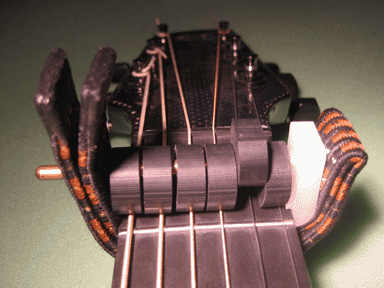Delivered.
Tuesday, November 15, 2011
Thursday, November 3, 2011
The great Partial Capo Experiment begins.
And so a very good man, Steve Cornish, did sell me a Third Hand capo this evening,
and verily I did place it upon my Ovation (strung to C2G2D3A3E4B3) in the initial position 220000, and began to play.
Oh dawggy, this is going to be an interesting ride.
I'm exhausted now--was tired when I started this, but like hell I was going to go to sleep without at least trying it out--but nonetheless tonight I tried 220000, 220002, and 001111. With the 220002 configuration I also brought the first string up a half-step so that the open pitches were DADAED, which was interesting to say the least.
Very eye-opening session. Harvey Reid is the primary advocate of the partial capo, and he seems to have a lot of ideas about how to use it. Most interesting for me is the concept that open pitches can be altered while notes up the neck remain the same, and you know what, that shit works! It opens up all kinds of open position fingerings you never thought of, while retaining the ability to play all the closed positions that you already know, up the neck. I was kind of expecting some cool factor on open string drones and bass notes, but I had not expected the impact it would have on melodic phrasing, especially in that "C-minor" centric arrangement of 001111. On the guitar (as opposed to the mandolin) the stretch to hit the m3 interval from a root note on the 5th fret of the next lower string is, indeed, a stretch, but with with a 001111 partial capo, you've got very comfortable access to that m3 and m7 and it's niice. Sure, technically you "lose" the major second, or rather you must now play it stopped on the root string, but this is a surprisingly easy tradeoff. My fingers just figured it out spontaneously, and then started playing things they don't normally gravitate toward. And then to go up the board you just...go up the board, find your root note, and play like you normally would. (Well...like someone who likes to tune the guitar in fifths would. :-)
Harmonics are going to be absolutely wild with this, and I suspect I'm going to have to just treat them separately for each possible configuration. Having an arrangement where the nodes offset each other from string to string is probably going to spawn some interesting stuff, and I look forward to it.
More to come. Just offhand I'm interested in checking out partial capoing over the third, fourth and fifth frets as well, and should start to experiment with some altered inner strings. Who the heck knows where it might lead?
Monster in the making. (Or, at least, inveterate geek.)
and verily I did place it upon my Ovation (strung to C2G2D3A3E4B3) in the initial position 220000, and began to play.
Oh dawggy, this is going to be an interesting ride.
I'm exhausted now--was tired when I started this, but like hell I was going to go to sleep without at least trying it out--but nonetheless tonight I tried 220000, 220002, and 001111. With the 220002 configuration I also brought the first string up a half-step so that the open pitches were DADAED, which was interesting to say the least.
Very eye-opening session. Harvey Reid is the primary advocate of the partial capo, and he seems to have a lot of ideas about how to use it. Most interesting for me is the concept that open pitches can be altered while notes up the neck remain the same, and you know what, that shit works! It opens up all kinds of open position fingerings you never thought of, while retaining the ability to play all the closed positions that you already know, up the neck. I was kind of expecting some cool factor on open string drones and bass notes, but I had not expected the impact it would have on melodic phrasing, especially in that "C-minor" centric arrangement of 001111. On the guitar (as opposed to the mandolin) the stretch to hit the m3 interval from a root note on the 5th fret of the next lower string is, indeed, a stretch, but with with a 001111 partial capo, you've got very comfortable access to that m3 and m7 and it's niice. Sure, technically you "lose" the major second, or rather you must now play it stopped on the root string, but this is a surprisingly easy tradeoff. My fingers just figured it out spontaneously, and then started playing things they don't normally gravitate toward. And then to go up the board you just...go up the board, find your root note, and play like you normally would. (Well...like someone who likes to tune the guitar in fifths would. :-)
Harmonics are going to be absolutely wild with this, and I suspect I'm going to have to just treat them separately for each possible configuration. Having an arrangement where the nodes offset each other from string to string is probably going to spawn some interesting stuff, and I look forward to it.
More to come. Just offhand I'm interested in checking out partial capoing over the third, fourth and fifth frets as well, and should start to experiment with some altered inner strings. Who the heck knows where it might lead?
Monster in the making. (Or, at least, inveterate geek.)
Subscribe to:
Comments (Atom)


